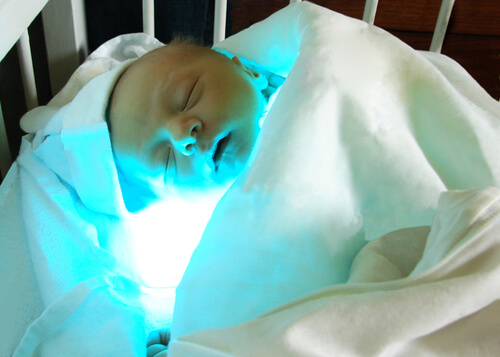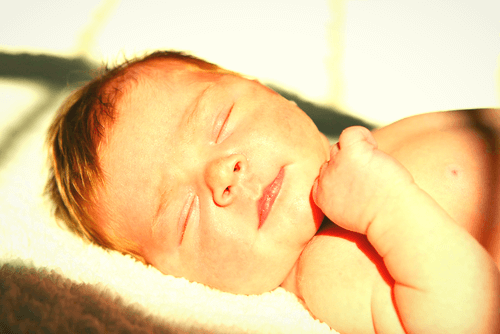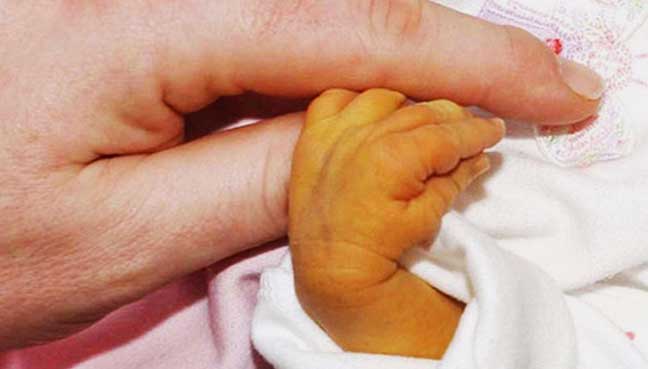What Is Infant Jaundice And How Is It Treated?

Infant jaundice occurs when bilirubin (which is a hemoglobin excretion) cannot be transformed in the liver or disposed of normally in the child’s waste.
This is the reason behind the yellow pigmentation typical of this illness.
The patient’s yellow color indicates that something isn’t functioning correctly in the liver.
Many babies and small children come to suffer infant jaundice because their livers aren’t mature yet. Therefore, the liver is unable to eliminate waste correctly.
Home test
To tell if your baby has jaundice, gently press on her nose and forehead with your finger.
If the skin keeps its yellow color when you lift your finger, then your child could have a slight case of jaundice.
If not, then the skin should become lighter than normal for an instant just after being pressed.
What are the different kinds of infant jaundice?
There are 2 types of infant jaundice. Although both are inoffensive, you should still observe your child attentively.
- Jaundice based on nourishment. This type of jaundice appears during a baby’s first weeks of life and may occur because your baby isn’t feeding well.
- The mother may be experiencing a delay in milk production. It’s important that newborns receive enough milk at each feeding and nurse 10-12 times each day.
- Jaundice because of the mother’s milk. Certain substances that make up breast milk can block certain proteins that decompose bilirubin.
- Your child’s pediatrician may recommend that you interrupt breastfeeding for a day or two to reduce bilirubin levels. You should only interrupt breastfeeding under doctor’s orders.
- If you do this, you can substitute your own milk with formula. Once the allotted time is up, you can go back to breastfeeding your baby. To keep your milk production flowing while your child is bottle feeding, you can use a breast pump.

More serious signs and symptoms
When infant jaundice is serious, there may be an incompatibility between the mother and baby’s blood. However, this isn’t common.
That’s why OB/GYNs ask pregnant mothers about their blood type. Knowing the mother’s blood type will help the OB/GYN foresee any possible complications regarding blood type incompatibility in order to take necessary precautions.
However, if you notice any of the following symptoms, take your baby to the pediatrician.
- Your baby’s skin is getting yellower and yellower, especially in the abdomen, arms and legs.
- Your baby looks sickly and it’s hard to wake him.
- Your baby has a very high-pitched cry.
- Hemorrhages.
- Hepatitis.
- Fever and vomiting.
- Your baby is constantly looking upwards.
- Your baby seems very anxious.

Causes
Besides incompatibility between the mother and baby’s blood types, jaundice may also be due to the following causes:
- Premature birth.
- The use of forceps during birth.
- Abnormally shaped blood cells.
- Lack of enzymes.
- Low hypoxia level.
- Congenital infections, like rubeola, syphilis, etc.
- Blood infections in the baby, also known as septicemia.
Treatment
There are different treatments to help babies overcome jaundice. Some can be carried out in the home, and others require taking the baby to the doctor.
- Sun baths. This treatment method involves exposing the baby to sunlight between 9am and 4pm. You must be sure to cover your baby’s eyes and genitals and change her position constantly.
- Check the levels of bilirubin in your baby’s blood periodically.
- Phototherapy. Phototherapy consists of placing blue lights on the baby while he’s in an incubator with his eyes covered. This treatment involves a hospital stay.
- Feeding. Another method involves getting the baby to take in abundant breast milk or formula. This will make the baby dirty her diaper more frequently, thus eliminating waste.
All cited sources were thoroughly reviewed by our team to ensure their quality, reliability, currency, and validity. The bibliography of this article was considered reliable and of academic or scientific accuracy.
- Gartner LM. Neonatal jaundice. Pediatr Rev 1994; 15: 422-32.
- Moyer V, Freese DK, Whitington PF, Olson AD, Brewer F, Colletti RB, et al; North American Society for Pediatric Gastroenterology, Hepatology and Nutrition. Guideline for the evaluation of cholestatic jaundice in infants: recommendations of the North American So ciety for Pediatric Gastroenterology, Hepatology and Nutrition. J Pediatr Gastroenterol Nutr 2004; 39: 115- 28.
- Rodríguez J, Figueras J. Ictericia neonatal. Protocolos Diagnóstico Terapeúticos de la AEP: Neonatología. 372- 383. [En línea].